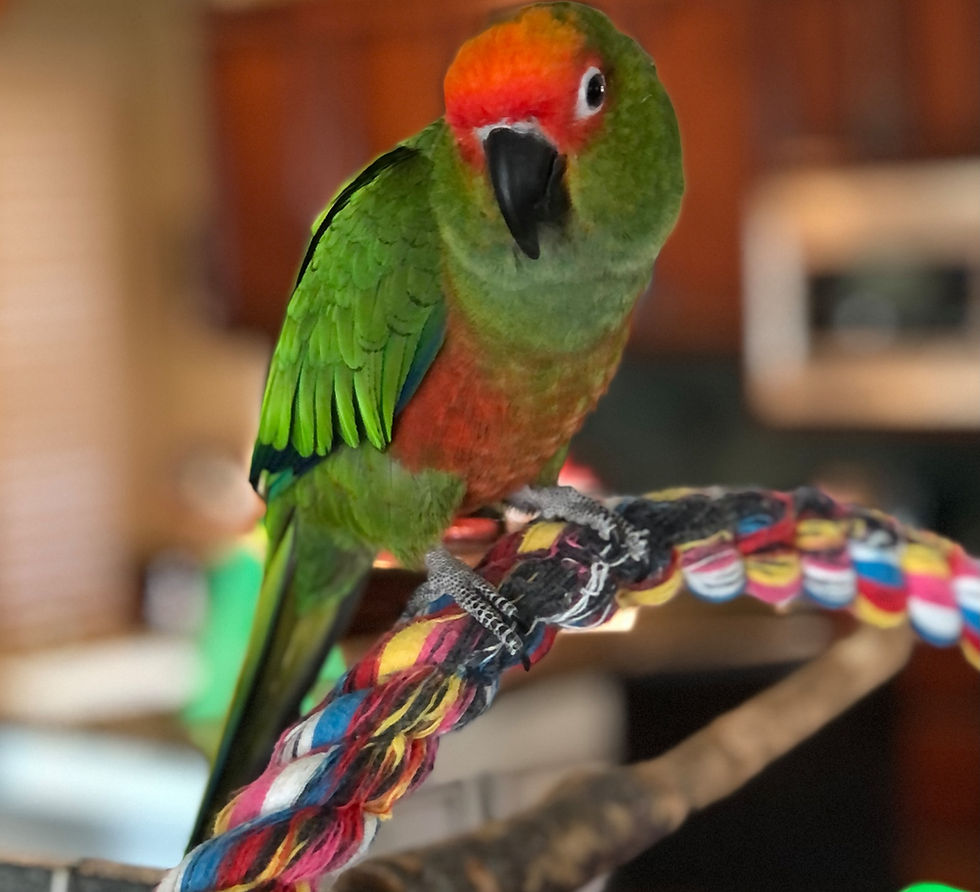
GOLD-CAPPED CONURE
The Golden-capped conure is a vibrant, lively parrot species that hails from Brazil and Paraguay's subtropical forests. In the wild, they can be found in flocks of 30 or more birds. Having reached Near-Threatened status, their wild numbers have been dwindling due to habitat loss due to deforestation.1
They are colourful, loveable, and full of personality. These sweet-natured parrots can make wonderful long-term companions.
The Golden-capped conure belongs to a taxonomic group called Aratinga, a genus of South American conures that look alike and have similar physical characteristics. Other members in this genus include the Sun conure and Jenday conures.
Native to Brazil and Paraguay, the Gold-capped conure resides in the subtropical and tropical dry forests, moist lowland forests, dry savanna, and plantations of their homeland.
They tend to be found in flocks of 30 or more and spend their time foraging for food and nesting high in the treetops. At one time, when the wild population was abundant in their native lands, it quickly vanished due to deforestation.
Temperament
Golden-capped conures are very outgoing, social birds and will enjoy being near their human companions as much as possible. They are very intelligent and respond well to training with positive reinforcement. If trained properly and given exposure to consistent communication, they can even learn to repeat words and perform tricks.
Conures are known for being active and playful. Chewing, climbing, dancing, and swinging are popular among these birds. They will need a spacious and enriching environment full of toys and various forms of entertainment. They can get destructive if left unsupervised around household items.
You can expect your Gold-capped conure to long for your time and affection. They love to cuddle and will happily crawl inside your shirt or upon your shoulder and go along for the ride. Quality time with their human companions is essential for their mental health. They make for a pretty comical household pet.
You will need to implement proper training to ensure you have a well-mannered bird.
Gold-capped Conure are
-
Friendly and playful
-
Cuddly
-
Entertaining and comical
Live for 20 to 30 years


Speech & Vocalizations
Golden-capped conures have a signature high-pitched, shrill screech. They tend to vocalize the most when excited, longing for attention, or startled.
They can learn to speak a few words and phrases but will not have a vast vocabulary. The Gold-capped conure does not speak as clearly as some other parrots.
The Gold-capped conure has a slightly larger build than the Sun and Jenday conures. They do not reach full coloration until approximately one year of age.
They have green bodies that can take on a more aqua hue in the sunlight. The eyes are surrounded by a white ring with a red band surrounding the white area, and the forehead is traced. There are varying hues of yellow, green, and blue within the tail and the signature golden crown at the top of the head.
Caring for the Gold-Capped Conure
You’ll want a spacious cage for the Golden-capped conure. They need the ability to move around and implement their physical activity needs within their enclosure. Perches, swings, ladders, bells, and bird-safe chewable toys are important to have available.
Gold-capped conures can get along well with other conures and birds that are the same size or smaller. It is hard to determine whether an individual bird will be compatible with another. Gold-capped conures can thrive as a single bird if they get at least two hours of human interaction daily and are not left alone for more than 6 to 8 hours.
The Gold-capped conure’s diet should consist of Good Quality birdseed, fruits, vegetables, and Sprouted seed.
Diet and Nutrition
A varied and well-balanced diet must be maintained at all times
Exercise
Gold-capped conures will require exercise and socialization.
Toys, ropes, ladders, and perches will encourage movement and activity. Gold-capped Conures like to be interactive with their surroundings. You must commit your time to your bird’s daily exercise needs and supervise any time spent out of the cage. You can also keep them active by teaching them tricks and playing along with their antics.
To Check For Availability